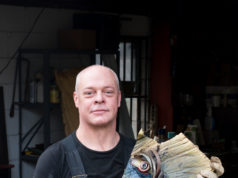Studio Players Shine In Wait Until Dark
There is a condition worse than blindness, and that is, seeing something that isn’t there. —Thomas Hardy
by Kim Thomas
What a difference a month makes. At last Sunday’s “fight call” for Frederick Knott’s famed stage thriller, Wait Until Dark, at Studio Players, the mood had switched from the exploratory anticipation first on display at a snowy Valentine’s Day rehearsal to a raw, intense atmosphere, and a nailing-down-the-details feeling filled the air as director Singleton, Eric Seale and Sharon Sikorski worked out the intricate details of struggles that had been carefully choreographed by Lexington’s own on-stage combat guru, Henry Layton. The theatre was now bustling with activity: the actors went through their paces and polished up their sparring, the sound technicians working out the final kinks, props were being brandished, and although the spine-tingling tale is a dark one of fear and terror, everyone onstage and off did their part to keep an overall lighthearted atmosphere on the circa 1960s set.
Singleton’s directorial style is to welcome feedback from the actors, and he seems to value their input as equal to – if not more than – his own instinct. With the suspenseful dialogue and action, the off-stage comic relief seems to be as important as the serious, edgy focus, and Singleton’s sense of humor keeps the players’ energy from falling into the abyss of emotion the script provides. He is joined in his jocularity by Seale, who, despite being a jovial and affable fellow, convincingly plays a creepy sinister nightmare of a conman in Wait.
Sikorski, as Susy, worked with a mobility trainer, Asbury College theology student Linda Chung, who has lost most of her sight and because the character of Susy is blind (the role was made memorable by Oscar-nominated Audrey Hepburn in the movie of the same name). Chung, who cheerfully anticipated needs and questions, spoke of how she became a linear thinker when she lost her sight, “I never remain at a diagonal position when I enter a room or cross a street, I focus on being ‘squared’ to the doors and walls. When an occasion arises that one gets lost, I always tell my students [she is an instructor who assists people who have recently become blind] to not panic. When that happens, I just think of ‘where did I go wrong, where do I remember being confident about my whereabouts?’—and then go back to that point and start over.” Chung clearly appreciates the nuances Sikorski will utilize to accurately portray Susy, and her expertise raises the believability bar.
Director Bob Singleton explains that Wait Until Dark is a technically demanding play, as written, from a set design standpoint, special effects, coordination of timing and tricky cues, heavy on the props and set pieces (and set in the 60s). Of course, no matter how early you start, there is always a final rush, there are always things that go off the rails. I’ve probably called in every favor I had.”
Today, the stage looks entirely different from the recent True West production, and Singleton emphasizes that he “Aesthetically and practically, the set is awesome (and I think we have one of the highest platforms in Studio history), but the set piece that has been the biggest challenge to acquire is a front-loading washer from the 60s. Research was done, people like Ellen Hellard and David Bratcher stalked through all kinds of Re-stores, Habitats, old appliance stores…scrolled through eBay and other online merchants…it got to the point where we were resigned to having to build it. David had one final idea, and although I was skeptical about the outcome, he contacted me and said he had found a 60s era washer/dryer combo that was exactly the size we needed in the (limited) space we had available, and we could loan it at no cost. It had been in storage for quite awhile. Never thought I’d be so happy to see a pigeon-shit covered, 40+ year old appliance. Perseverance and good cleaning products, 2 mainstays of theatre success!”
He points out that the contributions of both Linda Chung and Henry Layton were invaluable in bringing the play from page to stage. “Linda provided the understanding of Susy’s situation and the practical application of how Susy navigates daily life and unexpected encounters. We are lucky to have the opportunity to work with Linda. Her skills and experience (both as an individual with a visual impairment and as someone who helps others with transitioning into living with such an impairment) were extremely beneficial, and her upbeat personality and her spirit were bonuses. It was impressive to watch her come into a place she had never been to before, and within minutes see how she was able to skillfully navigate her way around, all while demonstrating and teaching us how she does it.”
Like many local theatre directors, Singleton is quick to sing the praises of Layton. “Henry was one of the first people I called; the fight choreography is crucial and very involved. The fact that it involves a blind woman adds to the challenge … and finally, the twist that is written into the script takes the choreography to a whole new level, so it’s imperative to have someone with Henry’s ability and experience. He knows how to demonstrate the proper techniques, his attention to detail is great, and he just has the ability to absorb the characters, storyline and stage setup and synthesize all the elements into a creative, believable and very effective sequence. The fight scenes will have people hanging onto their seats.” Singleton notes that he believes Chung’s and Layton’s “importance and their contributions simply can’t be overstated, even by me, and I can be pretty good at overstating things. Not in this case.”
He adds, “This is a good ol’ suspense/thriller with memorable characters, and lots of twists and turns as you watch the con-men work on Susy, and as you watch Susy start to see through the con and realize the danger she’s in, how she manages to level the playing field. And of course, there is a unique twist to the show that will have people holding their breath during it, and talking about it for a long time after.”
——————————————-
Sharon Sikorski performed a scene from Wait Until Dark for an acting class in college, “and ever since, I’ve wanted to do this show. There’s such a range of relationships, and Susy goes through so many experiences. In the course of a day, her strength and resourcefulness are pushed to the limit. I think the biggest challenges with playing Susy are, of course, playing someone who’s blind and also handling the steady build in pace and intensity. Of course, Linda has given helpful technical advice, but I think just as helpful were her confidence and sense of humor. Linda is both strong and very human. That’s how I want Susy to be.”
Eric Seale played conman Harry Roat in high school, and always “wanted a shot at it again when I was older. My father was also a fan of the character so when he passed away, I really wanted to take a run at it again. I like playing villains; they are incredibly free. Villains, especially extra nasty ones like Roat, have almost no boundaries. With a character like this you have no backstory, nothing in the script gives you a foundation for who the person is, you have to look at their actions and their words and really extrapolate to figure out where they come from and how to portray them.”
WAIT UNTIL DARK, by Frederick Knott
Directed by Bob Singleton
Performance Dates: March 18-21, 26-28, & April 2-4, 2010
Opening Night, Fridays & Saturdays: 8pm
Sunday Matinees: 2:30pm
Tickets: 859.225.0370 / lexarts.tix.com
More Info: http://www.studioplayers.org
Kim Thomas also writes about arts and activism at Kimmyville.blogspot.com







